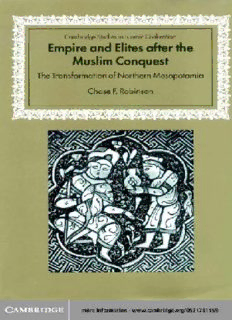
Empire and Elites after the Muslim Conquest: The Transformation of Northern Mesopotamia PDF
Preview Empire and Elites after the Muslim Conquest: The Transformation of Northern Mesopotamia
This page intentionally left blank Empire and Elites after the Muslim Conquest The study of the early Islamic historical tradition has flourished in recent years with the emergence of new and innovative scholarship no longer dependent on more tradi- tional narratival approaches.Chase Robinson’s book,which takes full account of the latest research,interweaves history and historiography to interpret the political,social and economic transformations in northern Mesopotamia after the Islamic conquests. Using Arabic and Syriac sources to elaborate his argument,the author focuses on the Muslim and Christian élites,demonstrating that the immediate effects ofthe conquests were in fact modest ones.Significant social change took place only at the end of the seventh century with the imposition of Marwa¯nid rule.Even then,the author argues, social power was diffused in the hands of local élites.This is a sophisticated study at the cutting-edge of a burgeoning field in Islamic studies. . is University Lecturer in Islamic History at the University of Oxford,and a fellow of Wolfson College. CAMBRIDGE STUDIES IN ISLAMIC CIVILIZATION Editorial board David Morgan (general editor) Virginia Aksan, Michael Brett, Michael Cook, Peter Jackson, Tarif Khalidi, Roy Mottahedeh,Basim Musallam,Chase Robinson Published titles in the series are listed at the back ofthe book Empire and Elites after the Muslim Conquest The Transformation of Northern Mesopotamia CHASE F. ROBINSON University ofOxford The Pitt Building, Trumpington Street, Cambridge, United Kingdom The Edinburgh Building, Cambridge CB2 2RU, UK 40 West 20th Street, New York, NY 10011-4211, USA 477 Williamstown Road, Port Melbourne, VIC 3207, Australia Ruiz de Alarcón 13, 28014 Madrid, Spain Dock House, The Waterfront, Cape Town 8001, South Africa http://www.cambridge.org ©Chase F. Robinson 2004 First published in printed format 2000 ISBN 0-511-03072-X eBook(Adobe Reader) ISBN 0-521-78115-9 hardback To Emiko Contents Preface pageviii Acknowledgements xiii List of abbreviations xiv Note on dates and citations xv Map:The Fertile Crescent in the early Abbasid period xvi 1 Conquest history and its uses 1 2 The seventh-century Jazira 33 3 From garrison to city:the birth of Mosul 63 4 Christian élites in the Mosuli hinterland:the shaha¯rija 90 5 Islam in the north:Jaziran Kha¯rijism 109 6 Massacre and narrative:the Abbasid Revolution in Mosul I 127 7 Massacre and élite politics:the Abbasid Revolution in Mosul II 147 Conclusion 165 Bibliography 172 Index 200 vii Preface This study is intended to demonstrate that one can write Islamic provincial history in the post-conquest and Umayyad periods (c.640–750 CE),a time for which the source material is patchy, late and frustratingly inconsistent. The book’s method is to marry history and historiography; its concern is with Muslim and non-Muslim élites who lived in a peripheral area at a time of political and social change.The area – for the most part,present-day north- ern Syria and Iraq – was peripheral because the caliphs lived in the south, while the Muslim–Byzantine frontier lay to the north.It was a time of politi- cal and social change because, in defeating Byzantine and Sasanian armies, the Muslims would begin to transform a region heretofore divided between Byzantine east and Sasanian west into the northern tier of the Umayyad and Abbasid empires. To write seventh- and eighth-century history we must come to terms with our sources;and as long as early Islamic archaeology,epigraphy,papyrology and numismatics remain as underdeveloped as they presently are,this means coming to terms with authors who wrote well after the events they describe. We are thus forced to rely in large measure on the learned élite’s representa- tion of its past,and,this being representation rather than record,we can no longer subordinate the study of early Islamic historiography to historical reconstruction. The reader may find frustrating the interweaving of history and historiography that follows;and he may frequently feel that he is taking two steps forward only to take a third back.But he can at least take consola- tion in being forewarned, and perhaps also in knowing that the approach reflects what is now twenty years of fierce debate – and measurable progress – in the study of the early Islamic historical tradition. History and historiography are thus intertwined in several ways. We begin with northern Mesopotamia writ large, and then focus on the city of Mosul, then as now the principal city of northern Iraq. Although this plan certainly reflects the growing political significance ofthe city,it more closely corresponds to the quantity and quality of our sources. One can say something in detail about Mosul in the eighth century for the simple reason that a Mosuli native, Yaz¯ıd b.Muhammad al-Azd¯ı(d.c.334/945) did,writing a history ofMosul that · viii
Description: